Inconel 718 Hybrid Laser-Based Directed Energy Deposition and Wrought Component Characterization through Small Punch Tests
Abstract
:Featured Application
Abstract
1. Introduction
2. Materials and Methods
2.1. Optimal Process Parameter Definition
2.2. Hybrid Coupon Manufacturing for Small Punch Testing Characterization
2.3. Small Punch Test Procedure
3. Results and Discussion
3.1. Optimal Process Parameter Definition
3.2. Chemical Composition of the Raw Material and the Optimum Overlay
3.3. Powder Characterization
3.4. Mechanical Characterization of the Hybrid Coupons Based on the Small Punch Tests
4. Conclusions
- The SPT method is sensitive enough and useful to characterize mechanical properties at the different studied conditions: 100% wrought, 100% DED-LB, 50% wrought + 50% DED-LB, and 80% wrought + 20% DED-LB.
- The best mechanical properties are obtained for the 100% wrought sample, while the lowest are for the 100% DED-LB sample.
- The results obtained for samples that include a joining area between the wrought base and DED-LB-deposited material show that:
- ○
- The SPT values of the hybrid samples are below, but not far off, the weighted value of the SPT results of the pure samples: −4.5% for Rm and −17% for Rp0.2.
- ○
- Thus, the joining area is not the weak zone of the part, so it can be concluded that the overlay of Inconel 718 via DED-LB adhered correctly to the wrought Inconel 718 base.
- The comparison between the different correlations for the estimation of the mechanical properties show that, even not including the exact material in the correlation, the results can be adequately estimated if the correlation considers materials with a wide range of mechanical properties.
- The use of DED-LB for repairing Inconel 718 parts should be analyzed carefully if post-weld heat treatments are not applicable. The evolution of embrittling Laves phases is a source of decreases in the mechanical properties if the DED-LB is performed under conditions of high heat concentrations, as is the case of this work.
- Regarding the extension of the proposed SPT methodology for the joint area assessment, the approach of this work is applicable for a DED-LB overlay thickness as thin as 1.5 mm while meeting standard testing method requirements. This is achieved by employing the reduced size specimen (Ø3 mm) from the EN 10371-2021 [34] SPT standard and accounting both for the 20/80 positioning and the machining clearance for specimen extraction. This opens a field of research on joints in thin DED-LB-manufactured parts that did not have an ad hoc technique available yet.
Author Contributions
Funding
Data Availability Statement
Acknowledgments
Conflicts of Interest
References
- Malikov, A.G.; Golyshev, A.A.; Vitoshkin, I.E. Recent Trends In Laser Welding And Additive Technologies (Review). J. Appl. Mech. Tech. Phys. 2023, 64, 31–49. [Google Scholar] [CrossRef]
- Rodrigues, J.; Barter, S.; Das, R. The Role of Additive Manufacturing Towards Sustainable Aerospace Structures. In Proceedings of the Green Approaches in Sustainable Aviation, ISSASARES 2022, Sustainable Aviation, Melbourne, Australia, 25–27 November 2022. [Google Scholar] [CrossRef]
- Singh, G.; Mehta, A.; Vasudev, H. Sustainability of Additive Manufacturing: A Comprehensive Review. Prog. Addit. Manuf. 2024. [Google Scholar] [CrossRef]
- Sefene, E.M.; Hailu, Y.M.; Tsegaw, A.A. Metal Hybrid Additive Manufacturing: State-of-the-art. Prog. Addit. Manuf. 2022, 7, 737–749. [Google Scholar] [CrossRef]
- Srinivasan, D.; Ananth, K. Recent Advances in Alloy Development of Metal Additive Manufacturing in Gas Turbine/Aerospace Applications: A Review. J. Indian Inst. Sci. 2022, 102, 311–349. [Google Scholar] [CrossRef]
- Zhang, Y.; Lan, L.; Shi, Q. Microstructural evolution and precipitated phase characteristics in the fusion zone for the as-repaired Inconel 718 alloy by directed energy deposition additive manufacturing. Mater. Charact. 2023, 204, 113222. [Google Scholar] [CrossRef]
- Onuike, B.; Bandyopadhyay, A. Additive manufacturing in repair: Influence of processing parameters on properties of Inconel 718. Mater. Lett. 2019, 252, 256–259. [Google Scholar] [CrossRef]
- Ramiro, P.; Galarraga, H.; Pérez-Checa, A.; Ortiz, M.; Alberdi, A.; Bhujangrao, T.; Morales, E.; Ukar, E. Effect of Heat Treatment on the Microstructure and Hardness of Ni-Based Alloy 718 in a Variable Thickness Geometry Deposited by Powder Fed Directed Energy Deposition. Metals 2022, 12, 952. [Google Scholar] [CrossRef]
- Kang, M.; Jiang, M.; Sridar, S.; Xiong, W.; Xie, Z.; Wang, J. Effect of Multiple Repair Welding on Crack Susceptibility and Mechanical Properties of Inconel 718 Alloy Casting. J. Mater. Eng. Perform. 2022, 31, 254–261. [Google Scholar] [CrossRef]
- Fisk, M.; Lundbäck, A. Simulation and validation of repair welding and heat treatment of an alloy 718 plate. Finite Elem. Anal. Des. 2012, 58, 66–73. [Google Scholar] [CrossRef]
- Wu, J.; Xu, M.; Lin, S.; Zhang, Q.; Wu, X.; Tian, J.; Wang, Z. Refining microstructures and enhancing mechanical properties of Inconel 718 weldment via fast-frequency double pulsed waveforms adopting in FFP-TIG. J. Mater. Process. Technol. 2023, 314, 117882. [Google Scholar] [CrossRef]
- Ma, J.; Zhang, Y.; Li, J.; Cui, D.; Wang, Z.; Wang, J. Microstructure and mechanical properties of forging-additive hybrid manufactured Ti–6Al–4V alloys. Mater. Sci. Eng. A 2021, 811, 140984. [Google Scholar] [CrossRef]
- Zu, Y.; Cao, Y.; Zhen, Y.; Li, F.; Wu, G. Determination on the fracture toughness of the welded joints of X80 pipeline steels based on small punch test. Eng. Fract. Mech. 2023, 291, 109525. [Google Scholar] [CrossRef]
- García-Blanco, I.; García, T.E.; Cabezas, J.G.; González, R.; Álvarez, G.; Rodríguez, C. Use of the small punch test for mechanical characterization of co– based laser cladding joint. Eng. Fail. Anal. 2024, 159, 108129. [Google Scholar] [CrossRef]
- Taheri, M. Development of a novel method for measuring the interfacial creep strength of laser cladding coatings. Results Opt. 2022, 7, 100226. [Google Scholar] [CrossRef]
- Kim, B.J.; Sim, Y.B.; Lee, J.H.; Kim, M.K.; Lim, B.S. Application of small punch creep test for Inconel 617 alloy weldment. Procedia Eng. 2011, 10, 2579–2584. [Google Scholar] [CrossRef]
- Serre, I.; Vogt, J.-B. Mechanical properties of a 316L/T91 weld joint tested in lead–bismuth liquid. Mater. Des. 2009, 30, 3776–3783. [Google Scholar] [CrossRef]
- Li, J.-F.; Kawai, M.; Kikuchi, K.; Igarashi, T.; Kurishita, H.; Watanabe, T.; Kawasaki, A. Strength proof evaluation of diffusion-jointed W/Ta interfaces by small punch test. J. Nucl. Mater. 2003, 321, 129–134. [Google Scholar] [CrossRef]
- Courtright, Z.S.; Leclerc, N.P.; Kim, H.N.; Kalidindi, S.R. Critical Comparison of Spherical Microindentation, Small Punch Test, and Uniaxial Tensile Testing for Selective Laser Melted Inconel 718. Appl. Sci. 2021, 11, 1061. [Google Scholar] [CrossRef]
- Lu, F.-Y.; Wan, H.-Y.; Ren, X.; Huang, L.M.; Liu, H.L.; Yi, X. Mechanical and microstructural characterization of additive manufactured Inconel 718 alloy by selective laser melting and laser metal deposition. J. Iron Steel Res. Int. 2022, 29, 1322–1333. [Google Scholar] [CrossRef]
- Arrizubieta, J.I.; Klocke, F.; Klingbeil, N.; Arntz, K.; Lamikiz, A.; Martinez, S. Evaluation of efficiency and mechanical properties of Inconel 718 components built by wire and powder laser material deposition. Rapid Prototyp. J. 2017, 23, 965–972. [Google Scholar] [CrossRef]
- Trosch, T.; Strößner, J.; Völkl, R.; Glatzel, U. Microstructure and mechanical properties of selective laser melted Inconel 718 compared to forging and casting. Mater. Lett. 2016, 164, 428–431. [Google Scholar] [CrossRef]
- Lancaster, R.J.; Barnard, N.C.; Haigh, B.; Sackett, E.E.; May, P.E.; Douglas, R.J.; Britton, D.; Jeffs, S.P. Evaluating the efficacy of alternative small scale test methodologies in deriving the mechanical properties of additive manufactured materials. J. Mater. Res. Technol. 2023, 26, 9328–9345. [Google Scholar] [CrossRef]
- Wang, L.Y.; Zhou, Z.J.; Li, C.P.; Chen, G.F.; Zhang, G.P. Comparative investigation of small punch creep resistance of Inconel 718 fabricated by selective laser melting. Mater. Sci. Eng. A 2019, 745, 31–38. [Google Scholar] [CrossRef]
- Peng, J.; Gao, M.; Zhang, H.; Geng, X.; Liu, X.; Pan, H. Small punch creep test reveals the differences of high-temperature creep behaviours for laser powder bed fusion and Rolled Inconel 718 alloys. Mater. Sci. Eng. A 2023, 886, 145698. [Google Scholar] [CrossRef]
- ASTM E1086; Standard Test Method for Analysis of Austenitic Stainless Steel by Spark Atomic Emission Spectrometry. ASTM International: West Conshohocken, PA, USA, 2022.
- UNE-EN 10361; Aceros aleados. Determinación del Contenido de Níquel. Método por Espectrometría de Emisión óptica con Fuente de Plasma Inducido. AENOR: Madrid, Spain, 2016.
- ASTM E1019; Standard Test Methods for Determination of Carbon, Sulfur, Nitrogen, and Oxygen in Steel, Iron, Nickel, and Cobalt Alloys by Various Combustion and Inert Gas Fusion Techniques. ASTM International: West Conshohocken, PA, USA, 2018.
- ASTM E3205; Standard Test Method for Small Punch Testing of Metallic Materials. ASTM International: West Conshohocken, PA, USA, 2020.
- Miguel, I.; Berriozabalgoitia, I.; Artola, G.; Macareno, L.M.; Angulo, C. Small Punch Test on Jominy Bars for High-Throughput Characterization of Quenched and Tempered Steel. Metals 2023, 13, 1797. [Google Scholar] [CrossRef]
- García, T.E.; Rodríguez, C.; Belzunce, F.J.; Suárez, C. Estimation of the mechanical properties of metallic materials by means of the small punch test. J. Alloys Compd. 2014, 582, 708–717. [Google Scholar] [CrossRef]
- Donachie, M.J.; Donachie, S.J. Superalloys: A Technical Guide, 2nd ed.; ASM International: Materials Park, OH, USA, 2002. [Google Scholar] [CrossRef]
- Yu, X.; Lin, X.; Liu, F.; Wang, L.; Tang, Y.; Li, J.; Zhang, S.; Huang, W. Influence of post-heat-treatment on the microstructure and fracture toughness properties of Inconel 718 fabricated with laser directed energy deposition additive manufacturing. Mater. Sci. Eng. A 2020, 798, 140092. [Google Scholar] [CrossRef]
- EN 10371; Metallic Materials—Small Punch Test Method. CEN: Brussels, Belgium, 2021.
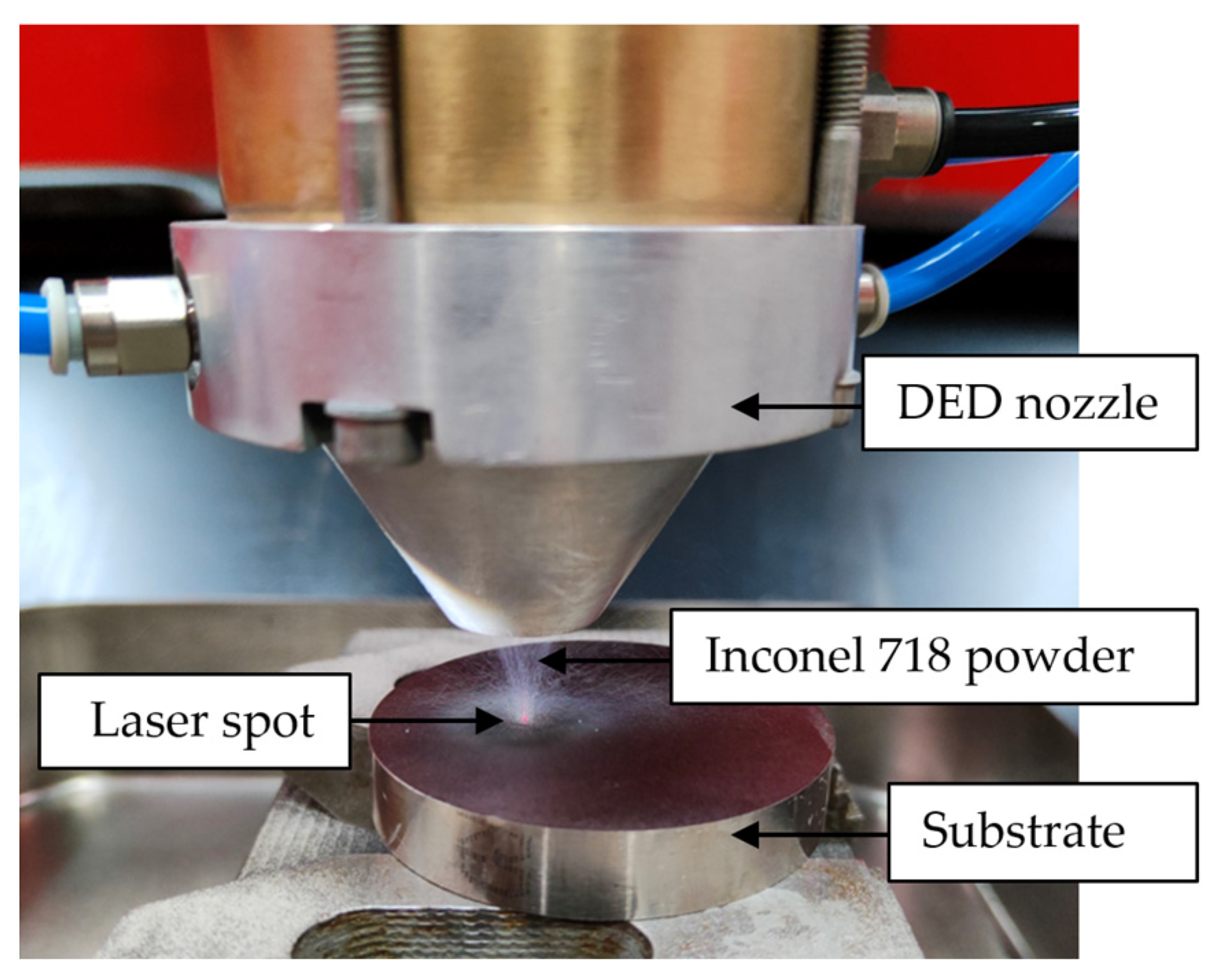
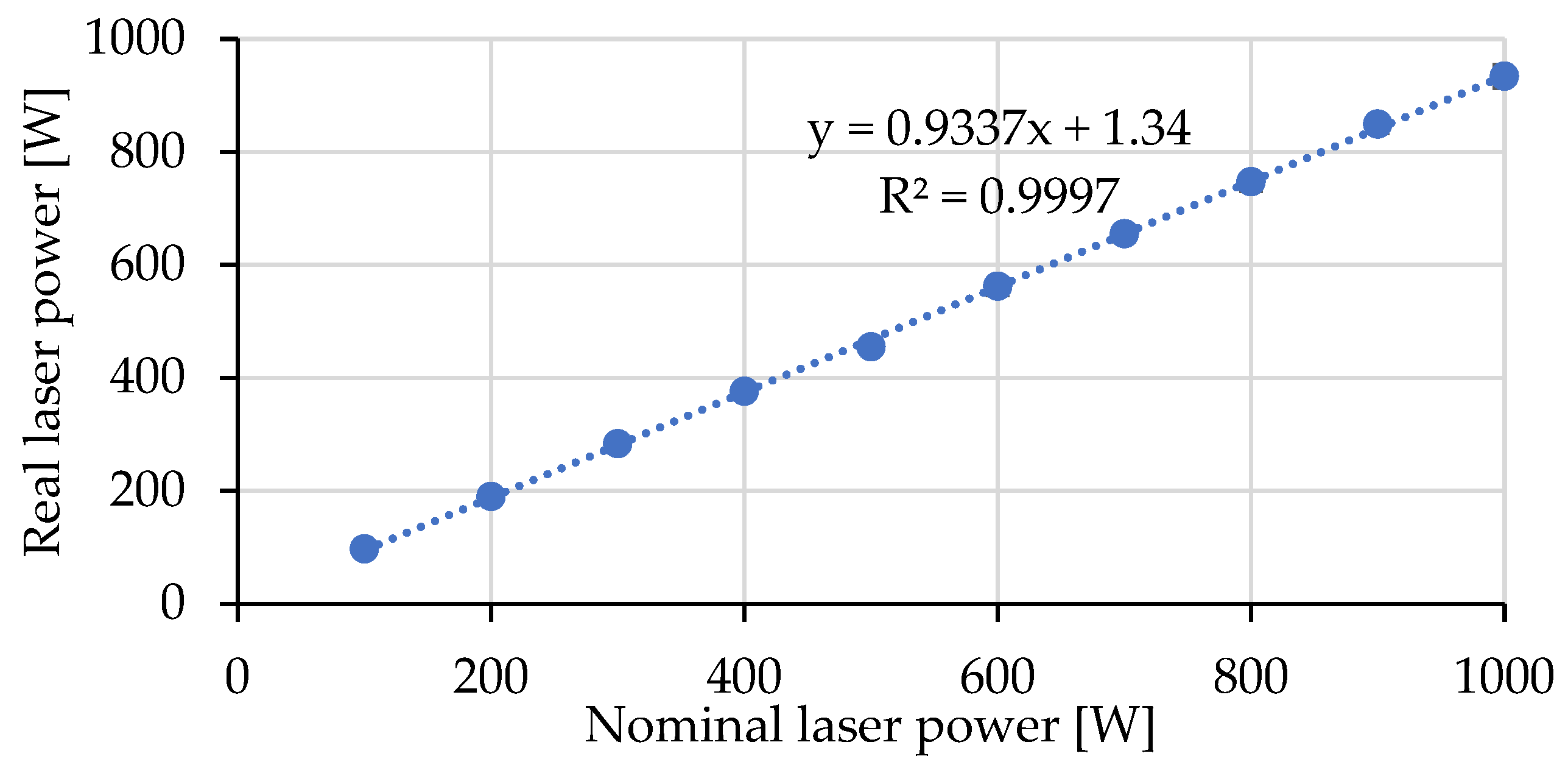
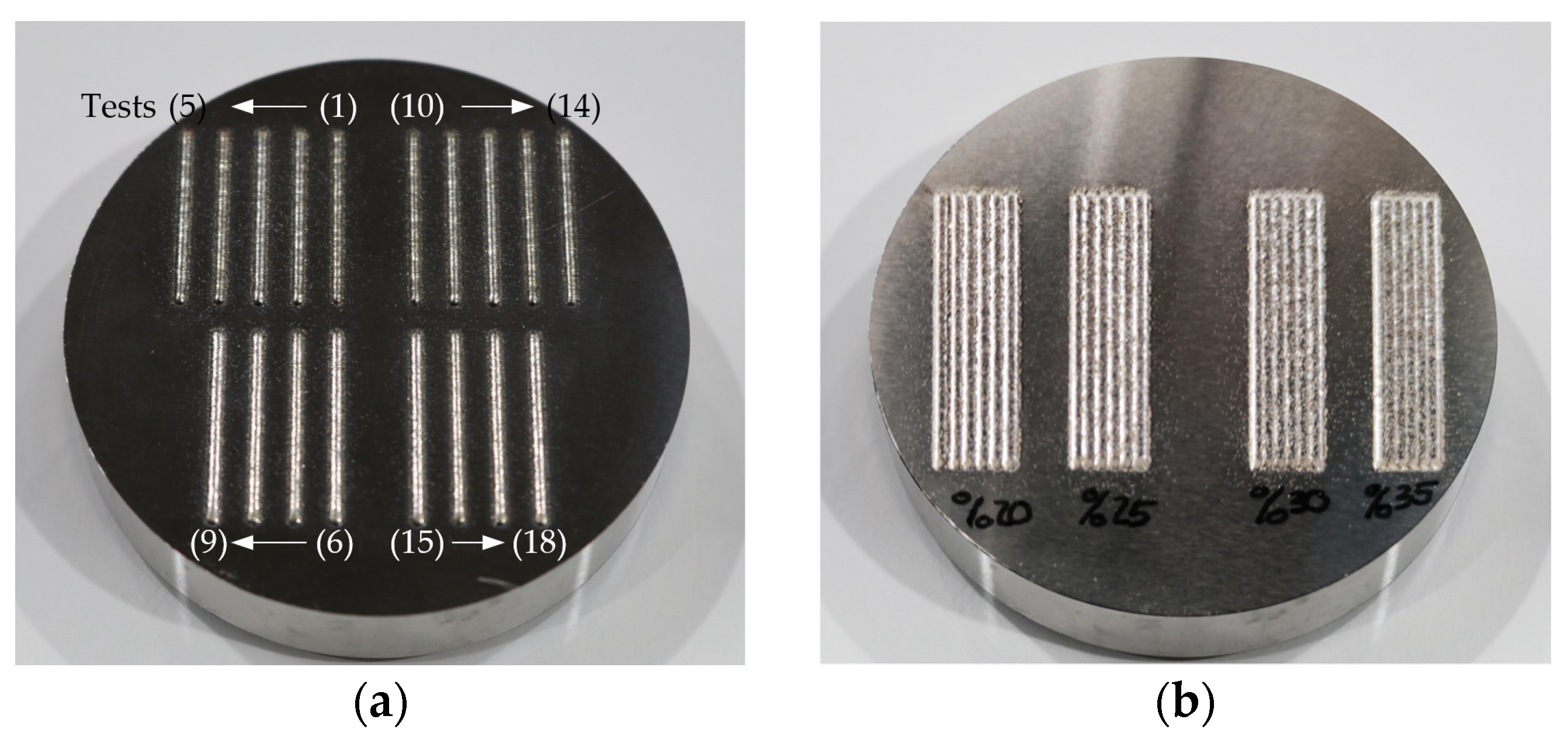
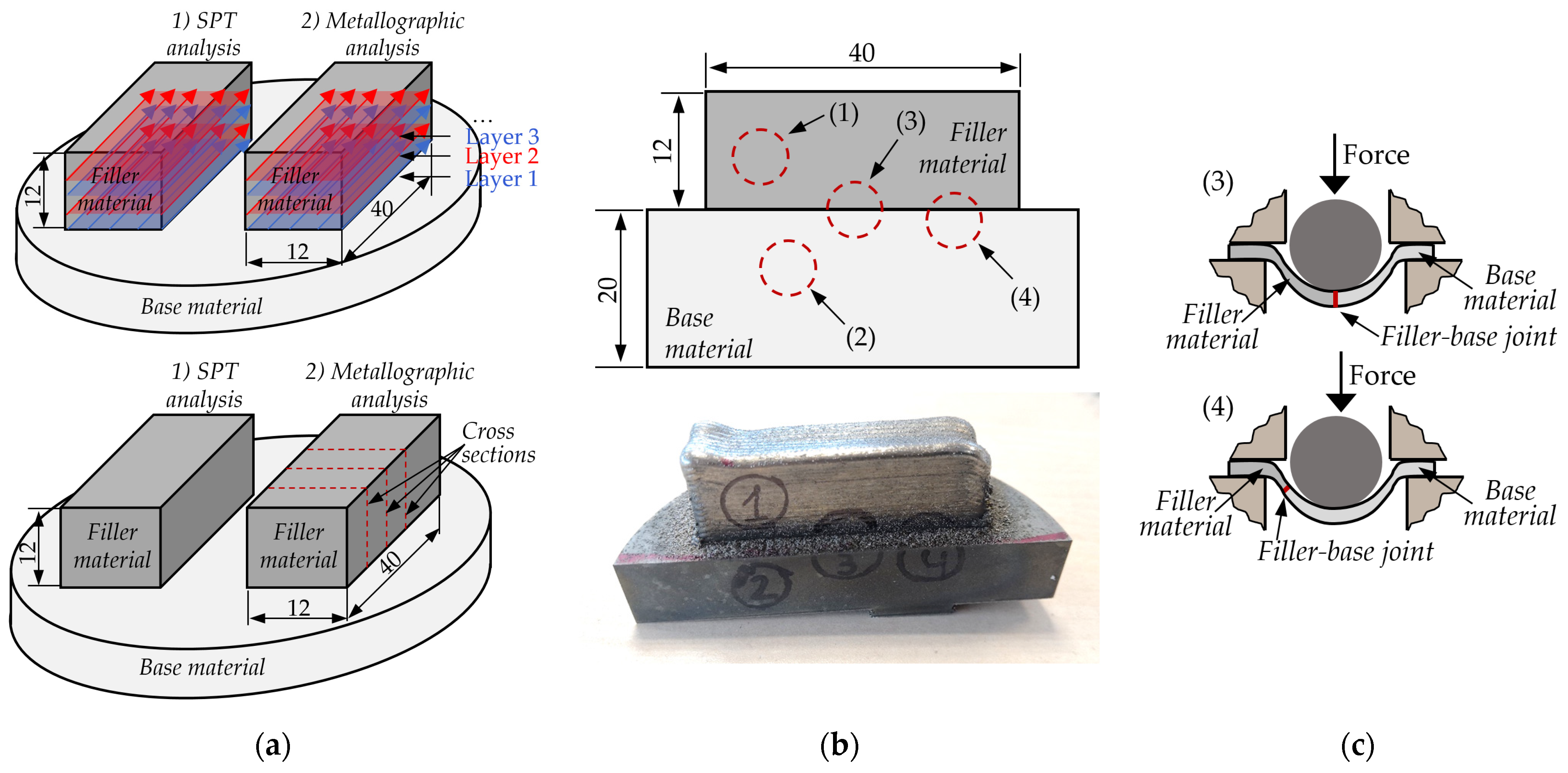
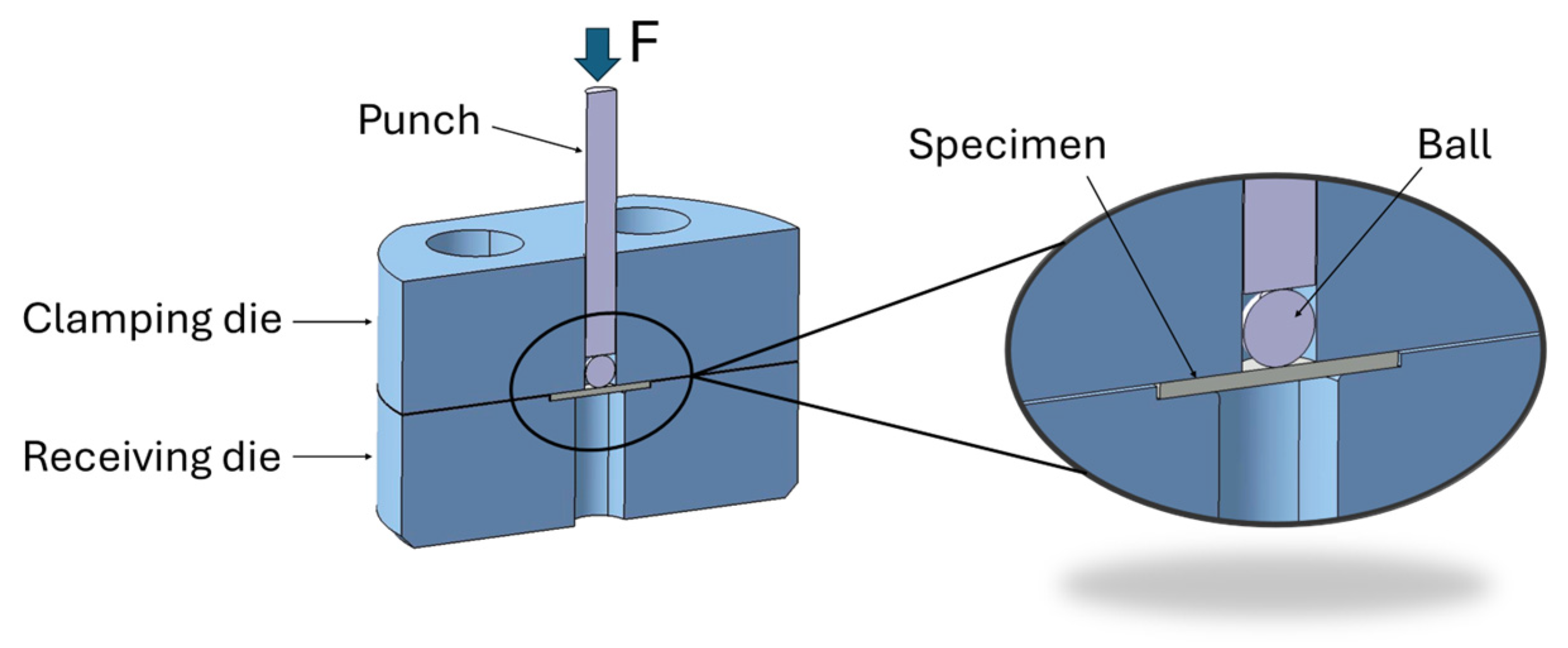


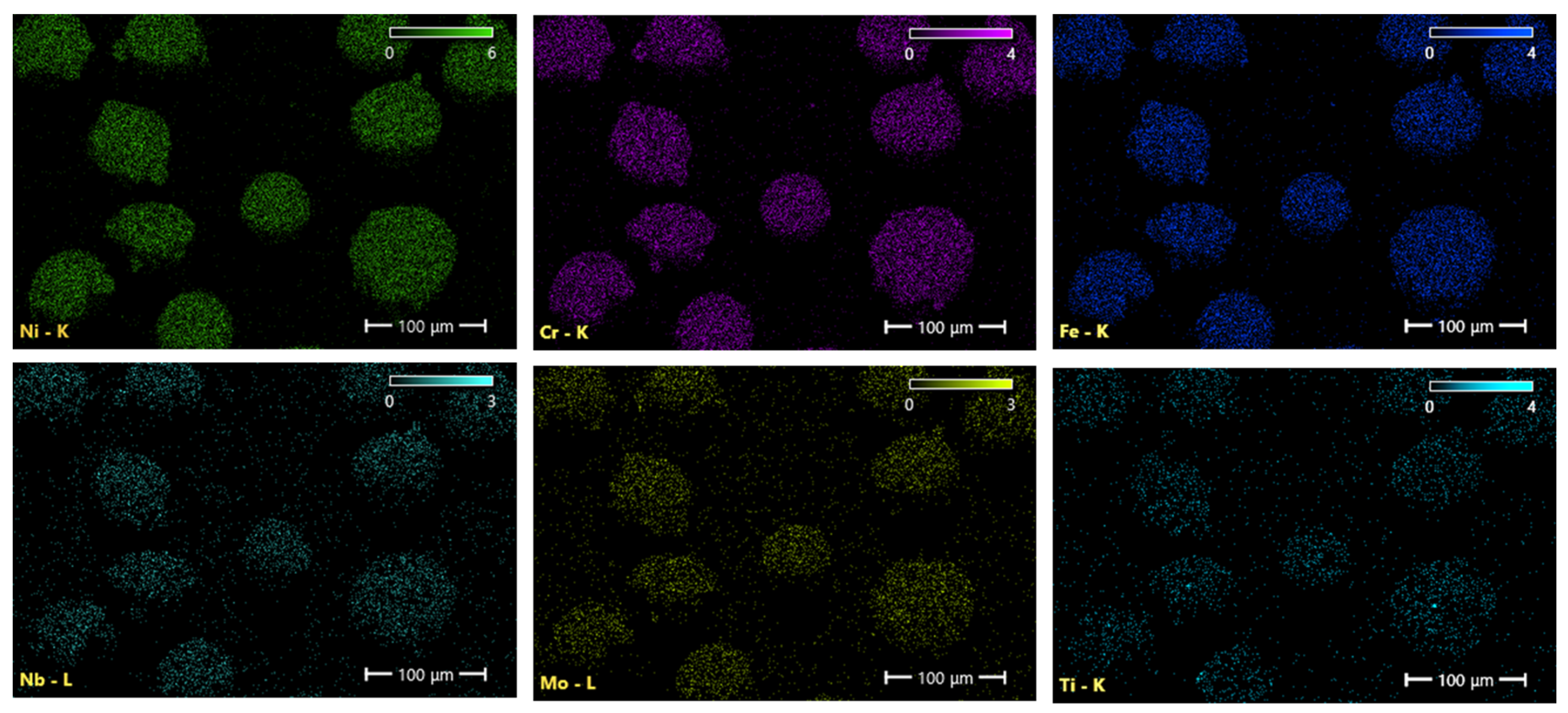

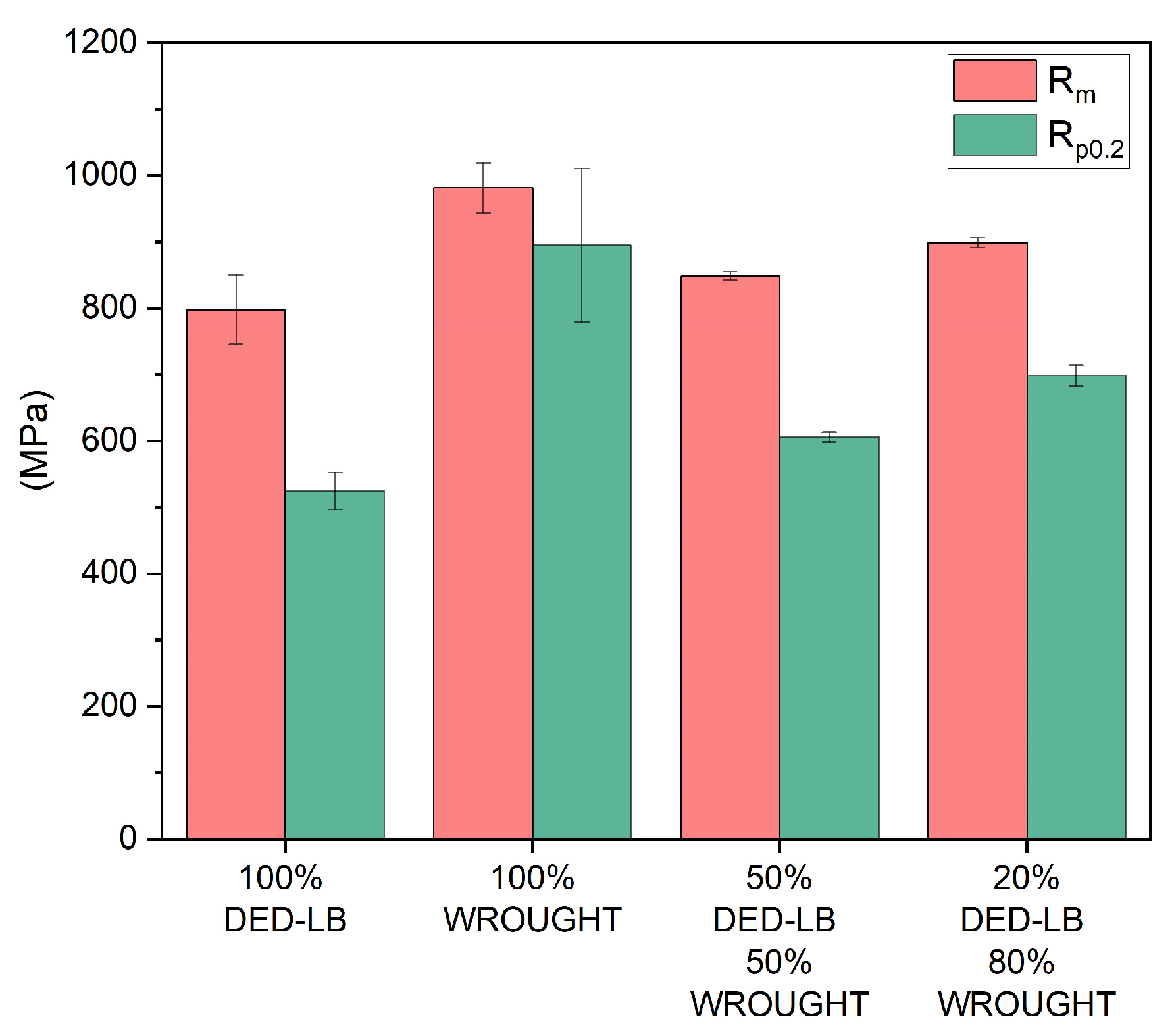
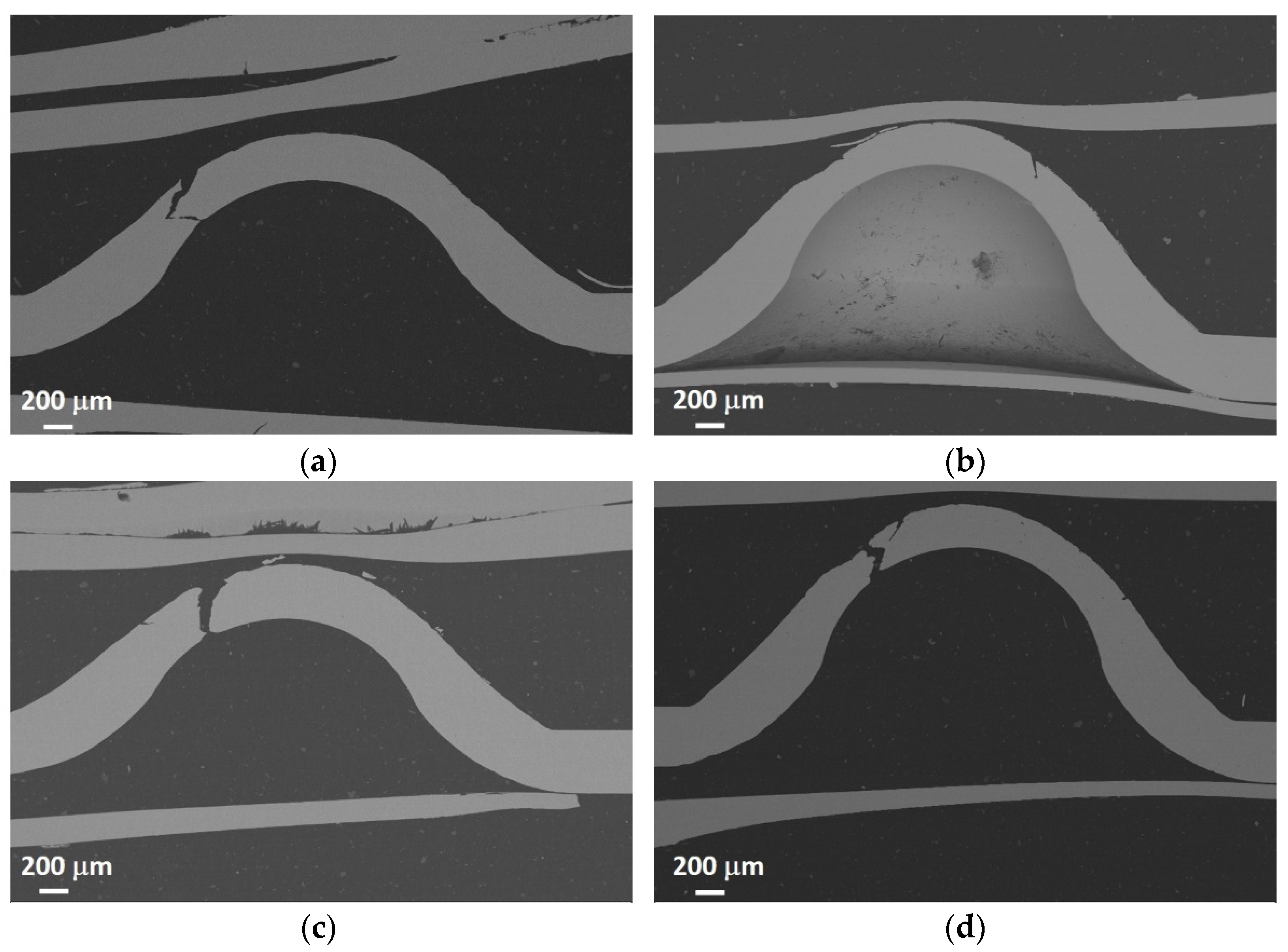
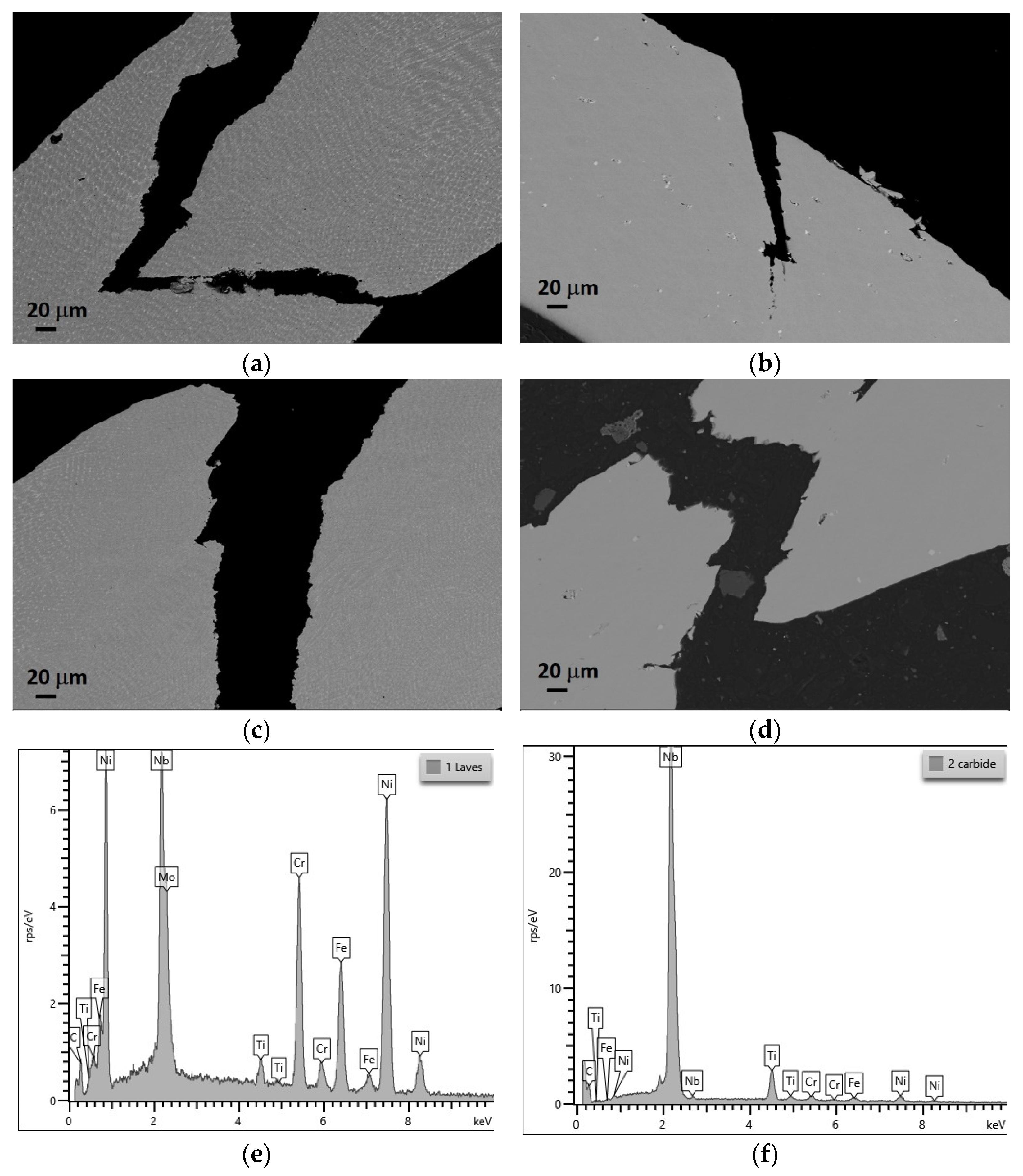
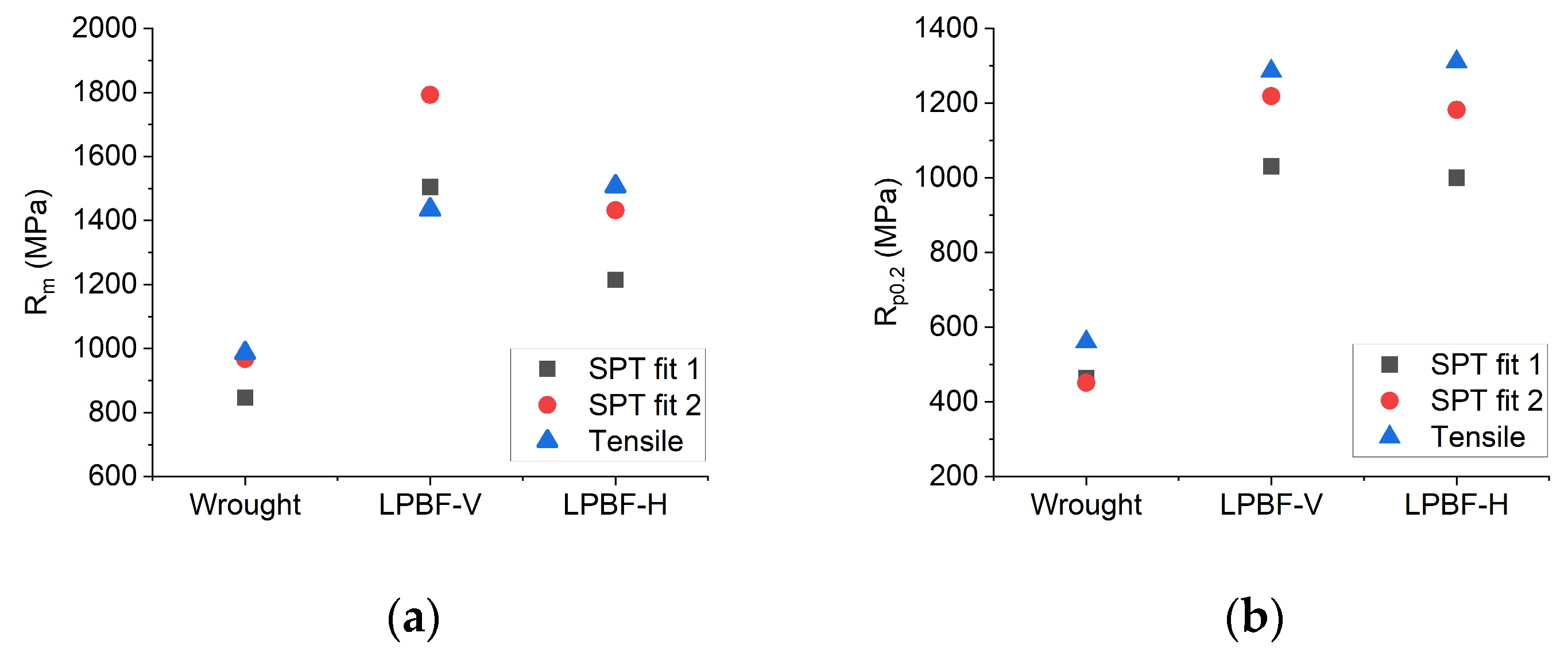
| Test Number | P [W] | F [mm/min] | Q [g/min] |
|---|---|---|---|
| 1 | 500 | 500 | 5.5 |
| 2 | 550 | 500 | 5.5 |
| 3 | 600 | 500 | 5.5 |
| 4 | 500 | 525 | 5.5 |
| 5 | 550 | 525 | 5.5 |
| 6 | 600 | 525 | 5.5 |
| 7 | 500 | 550 | 5.5 |
| 8 | 550 | 550 | 5.5 |
| 9 | 600 | 550 | 5.5 |
| 10 | 500 | 500 | 6.0 |
| 11 | 550 | 500 | 6.0 |
| 12 | 600 | 500 | 6.0 |
| 13 | 500 | 525 | 6.0 |
| 14 | 550 | 525 | 6.0 |
| 15 | 600 | 525 | 6.0 |
| 16 | 500 | 550 | 6.0 |
| 17 | 550 | 550 | 6.0 |
| 18 | 600 | 550 | 6.0 |
| Type | Name | Ni | Cr | Mo | Fe | Nb | Ti | Mn | C | Si | Al | Others |
|---|---|---|---|---|---|---|---|---|---|---|---|---|
| Wrought base | Inconel 718 | Bal. | 18.1 | 2.79 | 18.4 | 5.07 | 0.95 | 0.067 | 0.043 | 0.056 | 0.60 | <0.4 |
| Powder | Inconel 718 | Bal. | 18.9 | 2.91 | 18.0 | 4.83 | 0.86 | 0.074 | 0.039 | 0.034 | 0.49 | <0.2 |
| DED-LB deposited | Inconel 718 | Bal. | 18.5 | 2.90 | 17.4 | 4.93 | 0.78 | 0.074 | 0.047 | 0.042 | 0.49 | <0.2 |
| Reference | Rm (MPa) | Rp0.2 (MPa) | |||
|---|---|---|---|---|---|
| Average | Deviation | Average | Deviation | ||
| 100% DED-LB | Measured by SPT | 798 | 52 | 524 | 28 |
| 100% WROUGHT | Measured by SPT | 981 | 38 | 895 | 116 |
| 50% DED-LB + 50% WROUGHT | Measured by SPT | 848 | 6 | 606 | 7 |
| Weighed estimation (50/50) | 890 | - | 710 | - | |
| 20% DED-LB + 80% WROUGHT | Measured by SPT | 899 | 7 | 698 | 16 |
| Weighed estimation (20/80) | 944 | - | 821 | - | |
Disclaimer/Publisher’s Note: The statements, opinions and data contained in all publications are solely those of the individual author(s) and contributor(s) and not of MDPI and/or the editor(s). MDPI and/or the editor(s) disclaim responsibility for any injury to people or property resulting from any ideas, methods, instructions or products referred to in the content. |
© 2024 by the authors. Licensee MDPI, Basel, Switzerland. This article is an open access article distributed under the terms and conditions of the Creative Commons Attribution (CC BY) license (https://creativecommons.org/licenses/by/4.0/).
Share and Cite
Miguel, I.; Artola, G.; Arrizubieta, J.I.; Fernández-Calvo, A.I.; Angulo, C. Inconel 718 Hybrid Laser-Based Directed Energy Deposition and Wrought Component Characterization through Small Punch Tests. Appl. Sci. 2024, 14, 6420. https://doi.org/10.3390/app14156420
Miguel I, Artola G, Arrizubieta JI, Fernández-Calvo AI, Angulo C. Inconel 718 Hybrid Laser-Based Directed Energy Deposition and Wrought Component Characterization through Small Punch Tests. Applied Sciences. 2024; 14(15):6420. https://doi.org/10.3390/app14156420
Chicago/Turabian StyleMiguel, Ibon, Garikoitz Artola, Jon Iñaki Arrizubieta, Ana Isabel Fernández-Calvo, and Carlos Angulo. 2024. "Inconel 718 Hybrid Laser-Based Directed Energy Deposition and Wrought Component Characterization through Small Punch Tests" Applied Sciences 14, no. 15: 6420. https://doi.org/10.3390/app14156420





